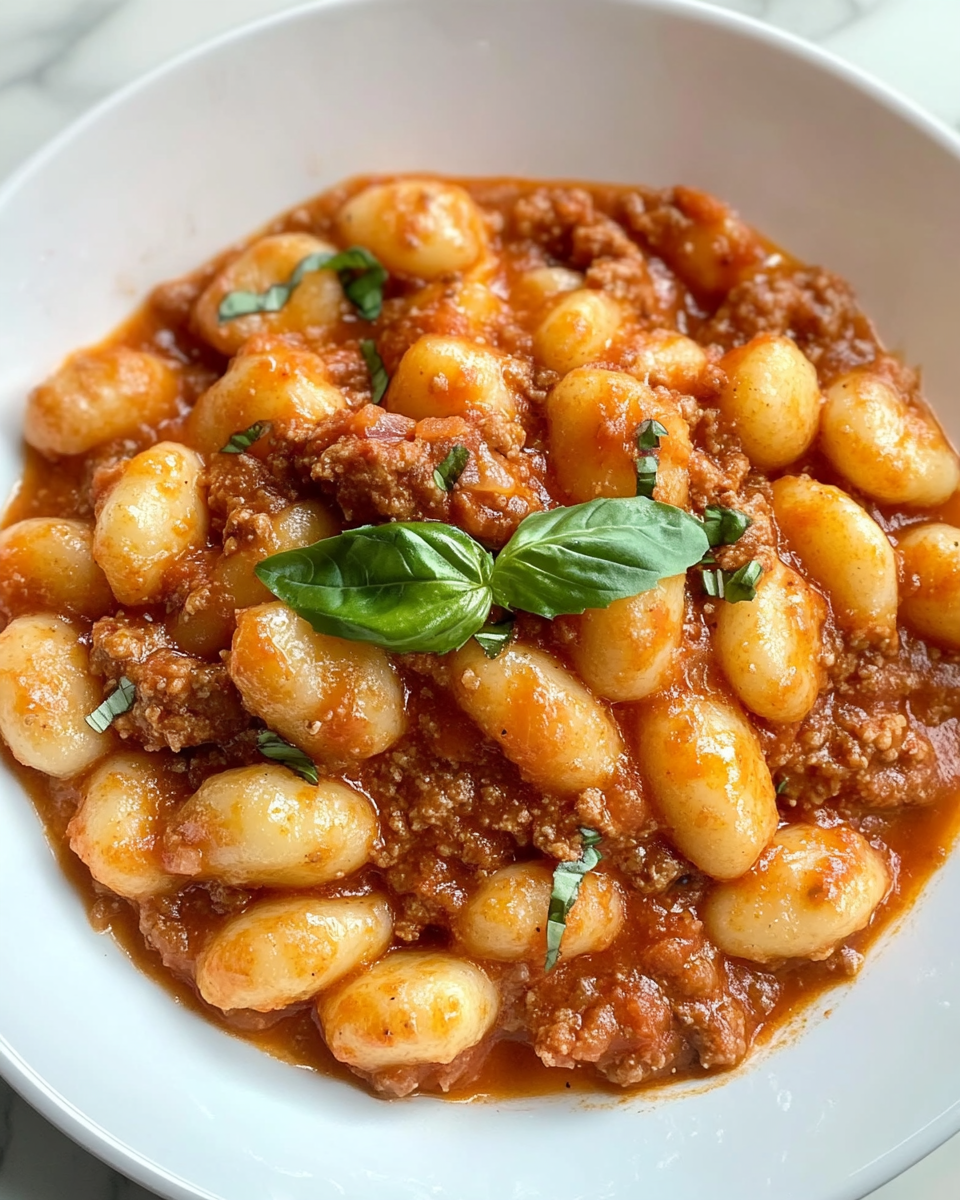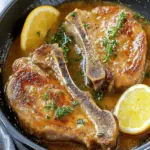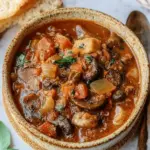Gnocchi Bolognese is a comforting Italian dish that combines pillowy potato gnocchi with a rich, meaty bolognese sauce. This hearty meal is perfect for a cozy weeknight dinner or a special occasion. The soft texture of the gnocchi complements the savory flavors of the sauce, creating a satisfying and flavorful dish.
Full Recipe:
Ingredients
- 2 tablespoons olive oil
- 2 stalks celery, diced
- 1 medium carrot, diced
- 1 medium yellow onion, diced
- 1 pound ground beef
- 1 tablespoon Italian seasoning
- 2 cloves garlic, minced
- 2 tablespoons tomato paste
- 28 ounces crushed tomatoes
- 1 cup water or stock
- 2 bay leaves
- 1 teaspoon crushed red pepper flakes
- 16 ounces gnocchi
- Salt and pepper to taste
- Fresh basil for garnish
Directions
- Prepare the Vegetables: In a large Dutch oven or skillet, heat olive oil over medium heat. Add the diced celery, carrot, and onion. Cook until the vegetables are soft and tender, about 5-7 minutes.
- Brown the Ground Beef: Add the ground beef to the skillet. Cook until browned, breaking it apart with a spoon as it cooks. Season with Italian seasoning, salt, and pepper.
- Add Garlic and Tomato Paste: Stir in the minced garlic and cook until fragrant, about 1 minute. Add the tomato paste and cook for another 2 minutes, allowing it to deepen in color.
- Simmer the Sauce: Pour in the crushed tomatoes, water or stock, and add the bay leaves and crushed red pepper flakes. Bring the mixture to a simmer. Let it cook for about 10 minutes, stirring occasionally.
- Cook the Gnocchi: Meanwhile, bring a large pot of salted water to a boil. Add the gnocchi and cook according to package directions, usually about 2 minutes, or until they float to the surface. Reserve about 1 cup of the starchy cooking water, then drain the gnocchi.
- Combine Gnocchi and Sauce: Add the cooked gnocchi to the bolognese sauce. If the sauce is too thick, add the reserved starchy water a little at a time until the desired consistency is reached. Stir gently to combine.
- Serve: Remove the bay leaves. Taste and adjust seasoning with salt and pepper as needed. Serve the gnocchi bolognese hot, garnished with fresh basil leaves.
Nutritional Facts
Per serving (based on 6 servings):
- Calories: Approximately 418 kcal
- Protein: 19g
- Fat: 21g
- Saturated Fat: 7g
- Carbohydrates: 41g
- Sugars: 8g
- Fiber: 5g
- Cholesterol: 54mg
- Sodium: 533mg
- Potassium: 723mg
- Vitamin A: 2087 IU
- Vitamin C: 16mg
- Calcium: 99mg
- Iron: 7mg
Why Gnocchi Works Perfectly with Bolognese Sauce
The soft, pillowy nature of gnocchi makes it an ideal vehicle for rich sauces like Bolognese. Unlike pasta, which can sometimes be dense or chewy, gnocchi melts in your mouth, allowing the sauce to coat each bite evenly and linger beautifully on the palate. The lightness of gnocchi balances the robust and meaty character of the Bolognese, creating a harmonious contrast in textures and flavors.
Gnocchi’s slightly chewy exterior paired with its tender interior complements the slow-cooked sauce, which is often thickened and intensified through hours of simmering. This balance makes Gnocchi Bolognese a dish that feels both luxurious and homey — perfect for comforting family meals or special occasions.
The Art and Science of Making Bolognese Sauce
What sets Bolognese sauce apart from other tomato-based meat sauces is its complexity and the slow cooking process that allows flavors to meld and deepen over time. The soffritto base, made with finely diced onions, carrots, and celery, provides a subtly sweet and aromatic foundation. This is then enriched by ground beef, which is browned to develop caramelized flavors through the Maillard reaction, a chemical reaction that enhances savory depth.
The addition of tomato paste and crushed tomatoes contributes acidity and sweetness, balancing the richness of the meat. Red wine is often incorporated to add layers of flavor and to help tenderize the meat further, while bay leaves and red pepper flakes bring subtle herbal and spicy notes.
Slow simmering is crucial; it allows the sauce to thicken naturally and for the ingredients to blend perfectly. This patient cooking transforms simple ingredients into a velvety, rich sauce that clings to gnocchi with perfect harmony.
The Cultural Significance of Gnocchi and Bolognese
Gnocchi and Bolognese sauce each hold significant places in Italian food culture. Gnocchi is often associated with comfort food and family traditions, frequently prepared on Sundays or holidays as a labor of love. It’s a dish that invites participation, with families sometimes making gnocchi together from scratch.
Bolognese sauce symbolizes hearty, home-cooked meals with roots in regional Italian cuisine. The Emilia-Romagna region is renowned for its culinary heritage, and Bolognese sauce is a signature of its rich, rustic fare. Serving Bolognese sauce over gnocchi instead of traditional tagliatelle or other pastas is a creative twist that reflects modern adaptations while honoring tradition.
This dish, therefore, represents both the preservation of Italian culinary roots and the evolution of food culture where classic recipes are adapted to new tastes and textures.
Health and Nutritional Perspective
From a nutritional standpoint, Gnocchi Bolognese is a balanced meal that provides a good mix of macronutrients. The beef in the sauce delivers a high-quality protein source, essential for muscle repair and growth. It also contains iron, zinc, and vitamin B12, which are important for energy production and immune function.
The gnocchi primarily offers carbohydrates, which serve as the body’s main energy source. Made mostly from potatoes and flour, gnocchi can be a lighter alternative to some pastas, depending on the recipe. The vegetables in the sauce contribute fiber, vitamins, and minerals, aiding digestion and overall health.
However, because the dish contains ground beef and oil, it can be moderate to high in fat and calories, so portion control is important, especially for those monitoring their fat intake. Using leaner cuts of beef or substituting with ground turkey or plant-based alternatives can make the dish lighter.
Variations and Customizations
Gnocchi Bolognese is incredibly versatile and lends itself well to customization. For instance, you can experiment with different types of meat, such as pork, veal, or a mix of meats, which is traditional in some Bolognese recipes. Some versions include pancetta or bacon for an extra smoky depth.
Vegetarian versions can be made by replacing the meat with mushrooms or lentils, which provide a similar umami richness. Adding cream or béchamel sauce can turn it into a richer, more decadent dish.
The gnocchi itself can be homemade or store-bought, with variations including sweet potato, ricotta, or spinach gnocchi, which add color and subtle flavor changes.
You can also experiment with herbs and spices — fresh basil, oregano, or even a hint of nutmeg can enhance the sauce’s complexity.
Serving Suggestions and Pairings
Gnocchi Bolognese is best served hot and fresh, often finished with a generous sprinkle of grated Parmesan or Pecorino Romano cheese to add saltiness and sharpness. A drizzle of high-quality olive oil or a few fresh basil leaves brightens the dish.
On the side, a crisp green salad or steamed vegetables balance the richness of the sauce. Garlic bread or crusty Italian bread is perfect for soaking up any leftover sauce.
For wine pairing, a medium-bodied red like Chianti, Sangiovese, or Barbera complements the meatiness of the Bolognese while balancing the acidity of the tomatoes.
The Comfort and Appeal of Gnocchi Bolognese
This dish’s appeal lies in its comforting nature. The soft gnocchi, the deep and savory sauce, and the warm, inviting aromas create a sense of homeliness and satisfaction. It’s the kind of meal that warms both the body and the soul, making it ideal for colder months or when you crave something hearty.
The ease of preparation, especially with store-bought gnocchi, makes it accessible for cooks of all skill levels. Yet, it remains a dish worthy of celebration, often chosen for dinner parties or special family gatherings.
Conclusion
Gnocchi Bolognese is a timeless dish that marries the delicate texture of gnocchi with the rich, slow-cooked flavors of a traditional Bolognese sauce. Its roots in Italian culinary tradition combined with its adaptability make it a perfect choice for both everyday meals and festive occasions.






